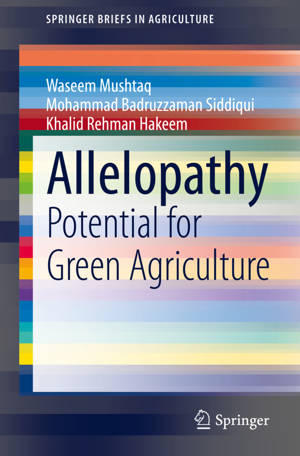
- Afhalen na 1 uur in een winkel met voorraad
- Gratis thuislevering in België
- Ruim aanbod met 7 miljoen producten
- Afhalen na 1 uur in een winkel met voorraad
- Gratis thuislevering in België
- Ruim aanbod met 7 miljoen producten
Allelopathy
Potential for Green Agriculture
Waseem Mushtaq, Mohammad Badruzzaman Siddiqui, Khalid Rehman HakeemOmschrijving
Allelopathic studies may be defined in various aspects; weed against weed/crop and vice versa. This book focuses on the ways to utilize the allelopathic potential of weeds or crops for controlling weeds in the agroecosystems. Vigorous use of herbicides is poisoning our environment at an alarming rate; allelopathy can be employed as a useful alternative to control weeds naturally under field conditions. The book contains chapters on the history of allelopathy; allelopathic potential of several important crops (rice, wheat, sorghum, maize, mustard, sunflower) and weeds (members of Solanaceae, Convolvulaceae, Asteraceae, Verbenaceae). Moreover, it highlights how the allelopathic potential of these weeds and crops can be employed effectively to suppress weeds under field conditions. The book also discusses topics on the role of allelochemicals in agroecosystems; impact on local flora; biotic stress induced by allelochemicals; mechanism of action of allelochemicals and future prospectiveof allelopathy. Prepared with basic concepts and importance of allelopathy, this book is intended for the agricultural community, botanists, students and researchers.
Specificaties
Betrokkenen
- Auteur(s):
- Uitgeverij:
Inhoud
- Aantal bladzijden:
- 69
- Taal:
- Engels
- Reeks:
Eigenschappen
- Productcode (EAN):
- 9783030408060
- Verschijningsdatum:
- 26/02/2020
- Uitvoering:
- Paperback
- Formaat:
- Trade paperback (VS)
- Afmetingen:
- 156 mm x 234 mm
- Gewicht:
- 122 g

Alleen bij Standaard Boekhandel
Beoordelingen
We publiceren alleen reviews die voldoen aan de voorwaarden voor reviews. Bekijk onze voorwaarden voor reviews.












